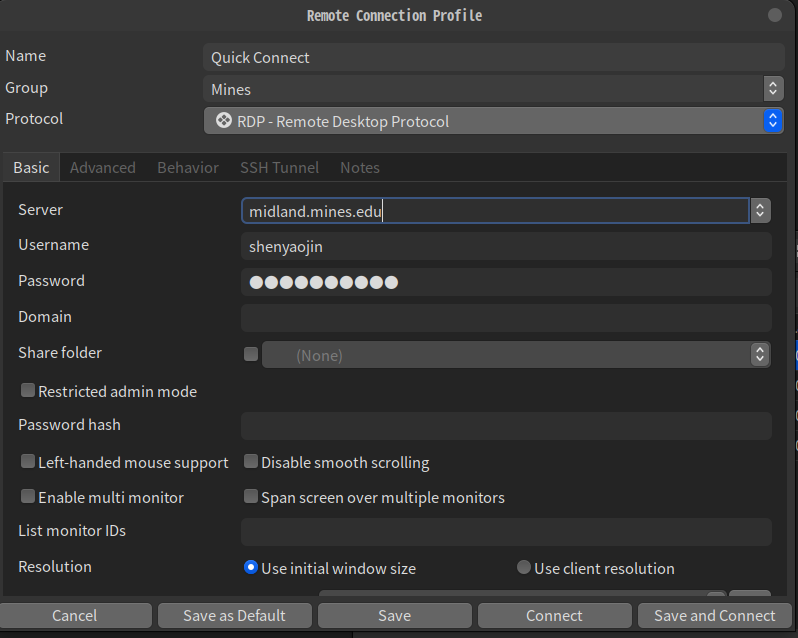Connect to RCP server
I have connected to Zhejiang University’s cluster server before, so it’s relatively easy to configure everything in Mines. 
Process the data
I decide to use MATLAB first. In common sense, MATLAB will perform a bit better than python while reading the data. However, I faced some problems while reading the data.
MATLAB’s version
Error using h5infoc
Unable to open the file because of HDF5 Library error. Reason:
H5Fget_obj_count not a file id
Error in h5info (line 125)
hinfo = h5infoc(filename,location, useUtf8);
Error in read_data (line 13)
info = h5info(file_name);
If the version is older than MATLAB 2022a it will return another error:
Error using h5infoc
The filename specified was either not found on the MATLAB path or it contains unsupported characters.
Error in h5info (line 108)
hinfo = h5infoc(filename,location, useUtf8);
Error in read_data (line 18)
info = h5info(filename);
That’s so weird. So I’ll try to use python now.
Python’s version
I will use h5py to read the data.
Use anaconda to install the package
conda activate base
conda install h5py
Read the data
Data:
DFOS_Class_deformation_UTC-YMD20210527-HMS192431.605_seq_00000000000
Output the resampling data
I resampled this data. Then there are about 22000 points each channel.
The output file size is around 120 Mb(in txt form).
Output the strain data
use “diff” to get the strain data. Here is a small question: I’m not quite sure that I need to do the differential before resampling (interval is 1 point, that means \(\Delta = a_{t+1} - a_{t}\) ) or after resampling(Interval is about 50 points, \(\Delta = a_{t+50} - a_{t}\)).
Anyway, I chose the latter method to do the differential because I believe it’ll be more reasonable.
Appendix: code here.
It is also saved in the working folder.
import h5py as h5
import numpy as np
import os
# This script is created by SY Jin on 9th Jul, 2022
# Tested on Linux(ubuntu 22.04 LTS).
# To read a DAS-record data file in python. (2G around)
# define the file name
file_name = "DFOS_Class_deformation_UTC-YMD20210527-HMS192431.605_seq_00000000000.hdf5"
new_name = file_name.strip(".hdf5")
# clear the flag of file.
os.system("h5clear -s %s" % file_name)
# Read the file into variation f
dataset = h5.File(file_name, 'r')
# reveal the dimension of the data.
dimension_data = list(dataset.keys())
deformation = dataset['deformation']
# print(dataset["/deformation/data"][0])
# <- this will output one channel(416 data)
# data:
# channel 1 2 3 ... 416
# time:
# 1
# 2
# ...
# 1095520
# output to a txt file.
# file_name
output_re_sampling_txt_filename = new_name + "_resampling.txt"
output_strain_txt_filename = new_name + "_strain.txt"
# output the re-sampling file
data = dataset["/deformation/data"]
shape_data = np.shape(data) # time, channel
f_resampling = open(output_re_sampling_txt_filename, 'w')
f_strain = open(output_strain_txt_filename, 'w')
interval = 50
for i in range(int(shape_data[0]/interval)-1):
temp_resampling = (data[interval*i]) # interval == 50
temp_strain = (np.abs(data[i+interval] - data[i]))
# write into file
for j in range(shape_data[1]): # number of channel
f_resampling.write(str(temp_resampling[j]))
f_resampling.write(" ")
f_strain.write(str(temp_strain[j]))
f_strain.write(" ")
f_resampling.write("\n")
f_strain.write("\n")
f_resampling.close()
f_strain.close()
文档信息
- 本文作者:Shenyao Jin
- 本文链接:https://shenyaojin.github.io/2022/07/09/summer-research-update/
- 版权声明:自由转载-非商用-非衍生-保持署名(创意共享3.0许可证)